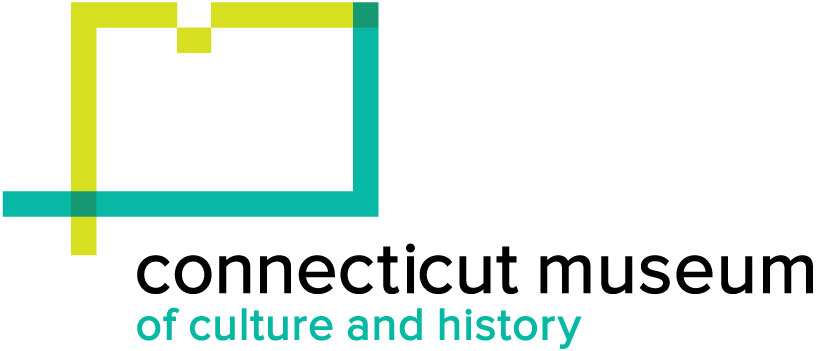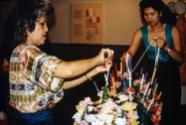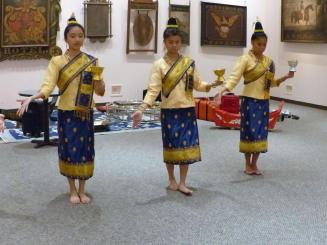Exhibit Installation - The Ties That Bind: Southeast Asian Wedding Traditions in New England
SubjectPortrait of
Thongchine Thongsythavong
(Laotian, 1937 - 1999)
SubjectPortrait of
Lynne Williamson
SubjectPortrait of
Manola Sidara
(Laotian)
Date1995
Mediumpositive color film slides
ClassificationsGraphics
Credit LineConnecticut Cultural Heritage Arts Program collections
CopyrightHeld by Lisa Gibson
Object number2015.196.416.1-.9
DescriptionPhotographs of the Lao component of the installation of the exhibition, "The Ties That Bind: Southeast Asian Wedding Traditions in New England." The exhibit was displayed at the Institute for Community Research from June 30 to September 15, 1995. The photographs were taken by Lisa Gibson, Institute for Community Research staff.
(.1) Image of Lao community scholar and wedding consultant Thongchine Thongsythavong setting up pah khouanes and candles.
(.2) Image of Thongchine Thongsythavong and Lynne Williamson arranging the Lao area in the exhibit, “The Ties That Bind: Southeast Asian Wedding Traditions.”
(.3-.4) Images of Manola Sidara preparing a flower for the pah khouane.
(.5) Image of Manola Sidara and Thongchine Thongsythavong arranging the strings on the pah khouane. These strings are tied to the wrists of both groom and bride during the wedding ceremony.
(.6) Image of Thongchine Thongsythavong and Manola Sidara holding an embroidered silk cloth from Laos. Thongsythavong uses this cloth to dress the groom in formal weddings.
(.7) Image of Thongchine Thongsythavong standing beside two wedding outfits on display in the exhibit.
(.8) Image of the completed Lao wedding arrangement.
(.9) Image of Thongchine Thongsythavong with her completed Lao wedding arrangement.
NotesSubject Note: “The Ties That Bind: Southeast Asian Wedding Traditions in New England” was an exhibition presented by CCHAP at the Institute for Community Research from June 30 to September 15, 1995. The exhibit was developed and circulated by the Vermont Folklife Center and other folklore organizations. The exhibit presented photographs and art works expressing wedding traditions practiced in the Lao, Cambodian, and Vietnamese communities that settled in America after the Viet Nam War. The title takes its name from the central wedding tradition of tying of the wrists of the bride and groom together by the monk officiating at the wedding, to symbolize their lifelong connection. For the Southeast Asian refugee communities in New England, numbering over 70,000 people, weddings have been occasions for great celebration. These ceremonies draw upon centuries-old pre-Buddhist traditions, which remain as important expressions of community cultural roots and shared values, along with elements borrowed from western ceremonies. Beautiful artifacts, displays of food, and traditional wedding clothes were arranged in three sections, one for each group, offering an impression of the most significant moments in the ritual and insight into their meaning for the participants. CCHAP collaborated with Lao educator and wedding cake maker Manola Sidara along with wedding planner Thongchine Thongsythavong and others in the Connecticut Lao community to include items from their wedding traditions in the exhibit, and Manola also brought her dance group, Lao Narthasin, to perform during the exhibit. Members of the Connecticut Cambodian community, especially court dancer Somaly Hay, also assisted with the exhibit.(.1) Image of Lao community scholar and wedding consultant Thongchine Thongsythavong setting up pah khouanes and candles.
(.2) Image of Thongchine Thongsythavong and Lynne Williamson arranging the Lao area in the exhibit, “The Ties That Bind: Southeast Asian Wedding Traditions.”
(.3-.4) Images of Manola Sidara preparing a flower for the pah khouane.
(.5) Image of Manola Sidara and Thongchine Thongsythavong arranging the strings on the pah khouane. These strings are tied to the wrists of both groom and bride during the wedding ceremony.
(.6) Image of Thongchine Thongsythavong and Manola Sidara holding an embroidered silk cloth from Laos. Thongsythavong uses this cloth to dress the groom in formal weddings.
(.7) Image of Thongchine Thongsythavong standing beside two wedding outfits on display in the exhibit.
(.8) Image of the completed Lao wedding arrangement.
(.9) Image of Thongchine Thongsythavong with her completed Lao wedding arrangement.
Subject Note: Pah Khuane - Originally made from banana leaves, these ornamental sculptures are used in Lao ceremonies and celebrations as a focal point for gathering people together and encouraging health and healing. They can also be an altar piece for a wedding ceremony, or given to people coming out of hospital to replenish their spirit. Khuan means spirit, and the decorations carry strings which are symbols of bonding and holding of the spirit, as also seen in Lao Buddhist ceremonies when the monk will tie a string around someone’s wrist as a sign of spiritual connection and well-being.
Subject Note: The baci/basi/ or Sou Khuane ceremony is often part of Lao Buddhist events as well as weddings, births, house warmings, or after a death. The practice by a monk or honored elder tying a white cotton thread around a person’s wrist, or tying a cotton thread around the wrists of a bride and groom, symbolizes the connection and well-being of the person’s or family’s spirit.
Biographical Note: Thongchine Thongsythavong (1937/8-1999) was a Lao wedding consultant and knowledgeable community scholar who was born in Laos and came to the United States as a refugee from the Viet Nam War, settling in East Hartford. She worked at GE Electro Components Co. in Glastonbury, Connecticut. She helped to establish the Wat Lao Temple in New Britain and was a volunteer and supporter of the activities of the Temple. Thongchine was a valued collaborator for CCHAP’s showing of the traveling exhibit “The Ties That Bind: Southeast Asian Wedding Traditions,” along with Manola Sidara, on view at the Institute for Community Research in 1995.
Biographical Note: Manola Sidara is a Lao dance educator and community activist whose life has been devoted to serving her community. Born in 1969 in Vientiane, Laos, Manola joined the National Dance School at the age of five, along with her sister. After her family fled Laos, she continued learning traditional dance with master dancer Sone Norasing in Colorado until moving to Connecticut in 1989. From her grandmother and aunts Manola learned to make pah khuane, the ornaments of bamboo leaves and flowers which are part of every Lao ceremony and celebration in both temple and home. She worked as a wedding consultant, organizing all the arrangements for traditional Lao weddings, and became known as a brilliant cake decorator. Manola helped to produce the exhibit The Ties That Bind: Southeast Asian Wedding Traditions at the Institute for Community Research (ICR) in 1995. In 1999-2000 she served as the Bilingual Program Assistant at Garfield School in Bridgeport, teaching ESOL, computers, and cultural awareness to elementary school children both Lao and Latino. Manola taught traditional dance at the Lao Saturday School in New Britain from its inception. With her high-school age students from the school, Manola formed the Lao Narthasin Dance Troupe, instructing the members in classical Laotian dance, folk dances of different ethnic groups in Laos, and traditional values and manners such as respectful behavior, honoring elders, and service to the family and community. The dance group, which has performed throughout Connecticut and Rhode Island at cultural centers and Lao temples, now includes a third generation of dancers. From 1998 to 2001 Manola was the New Britain Coordinator for the Urban Artists Initiative, a statewide training program run by the Connecticut Commission on the Arts and the Institute for Community Research. In 2001 Manola received an award from the Lao Association of CT at New Year for her work with the Lao Narthasin dancers and was selected as a CT Commission on the Arts Master Teaching Artist. In 2011 Manola coordinated the community oral history project After the Trauma: Holocaust Survivors and Laotian Refugees Confront the Past, displayed at the University of Hartford. Manola is also known as a master chef at East West Grille, her award-winning and beloved Lao-Thai restaurant on New Park Avenue in Hartford from 2000-2019, and the East-West Grille Food Truck. Manola is very active in assisting the Lao Temple in Morris, CT, with cultural programming, social service, and providing food for the monks and their ceremonies. For Manola, her tireless activities in dance, education, ceremonial decorations, and cooking all promote wellness, spirituality, bonding, and healing.
Subject Note: Connecticut was a major resettlement site for Southeast Asians in the 1980's. The Lao population numbers over 3000, living primarily in urban areas such as New Britain, Bridgeport, East Hartford, and Danbury and for a time in the 1990s-2007, in rural eastern Connecticut. While many Lao have found employment in factories, service industries, farming, and trades such as food, they continue to face barriers of language, lack of education, and lower income levels, all against a common backdrop of serious emotional wounds from the Viet Nam War era. Youth aged 10 - 19 years old have been by far the largest age group among Connecticut Southeast Asians. Maintaining young peoples’ awareness of heritage, culture, values, and language is a major goal of Lao leaders and parents. The Lao community sustains its traditional cultural practices in several ways. Several temples around the state provide gathering places where Buddhist monks and nuns offer spiritual services and cultural festivals. The largest temple is in Morris, where the resident monk Khoutavong has created exquisite Buddhist statues and traditional architecture with symbolic carvings, ornamentation, and shrines. Dancer and educator Manola Sidara developed and has directed Lao Narthasin, a traditional dance group now in its third generation of dancers. They perform classical, folk, and social dances that highlight cultural values such as respectful behavior and appreciation for elders. Manola also specializes in creating ceremonial decorations that express wellness, spirituality, and bonding during community celebrations, and she also promotes health and healing through her work as a master chef. The Lao Association of Connecticut formed in 1980 to unite the community and assist in economic development, cultural preservation, education, and health. For many years LAC offered classes in language, history, food and medicine, verbal arts, traditional music, and singing at Jefferson School in New Britain, and the group organizes several heritage festivals each year at the Morris temple that are attended by hundreds of Lao people. Other Lao community groups around the state also develop and present spiritual and cultural programs as well as health initiatives.
Additional audio, video, and photographic materials exist in the archive relating to this community and its artists.
Cataloging Note: This project was made possible in part by the Institute of Museum and Library Services MA-245929-OMS-20.
Status
Not on view





















